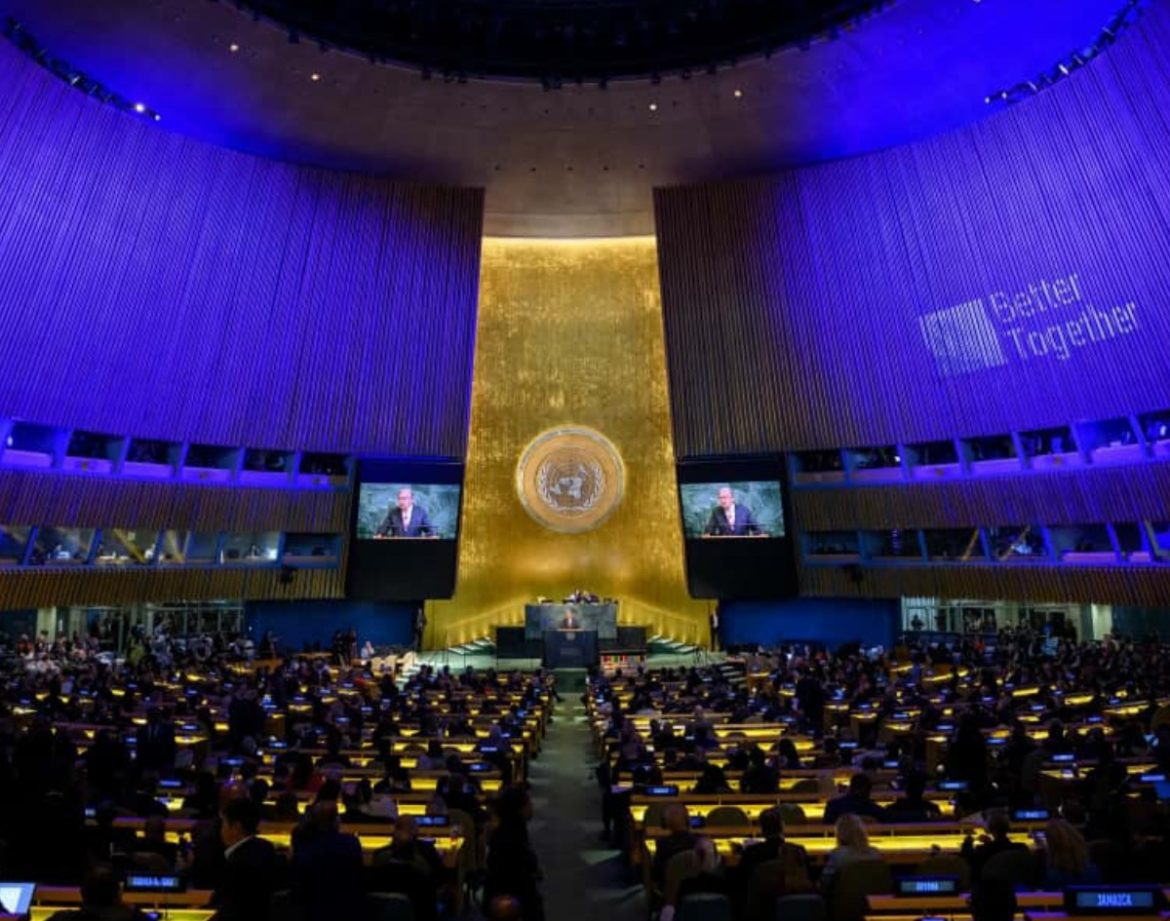By Augustine Igweshi
As the world’s leaders converge on New York for the 80th session of the United Nations General Assembly, humanity stands at a crossroads. The theme of this session, anchored in the Pact for the Future, places welcome emphasis on security, youth, and gender-issues that are inseparable from our shared destiny.
The stakes could not be higher. Wars and violent conflicts rage in multiple regions, displacing millions and sowing cycles of hatred.
The climate emergency is intensifying, pushing vulnerable communities into poverty, migration, and insecurity. Inequalities are widening between rich and 6 women, powerful and marginalized threatening the very fabric of societies. And yet, amid these mounting challenges, global governance appears increasingly fragmented, with mistrust, polarization, and nationalism undermining collective action.
This General Assembly can not be reduced to another ceremonial exchange of speeches and lofty declarations. It must serve as a turning point for multilateralism and moral leadership. The world is watching to see if leaders can rise above division and act with the courage and vision that this pivotal moment demands.
Youth: From Bystanders to Architects of Peace
One of the most urgent imperatives is to embrace youth as co-creators of solutions. Today’s young people are the largest generation in history. They are not merely inheritors of the future; they are already shaping it through their activism, entrepreneurship, and resilience. Across Africa, Asia, Europe, and the Americas, youth are mobilizing for climate justice, leading digital innovation, and pushing back against inequality and authoritarianism.
Yet, too often, they are sidelined in decision-making spaces. Their voices are heard in the streets but not in the halls of power. The Pact for the Future must recognize that no strategy for peace or sustainable development can succeed without meaningful youth inclusion. Investments in quality education, civic participation, digital literacy, and economic empowerment for young people are not optional—they are foundational to building peaceful societies.
As someone who has worked with young leaders through peacebuilding and diplomacy initiatives, I have seen their creativity, their courage, and their unwavering demand for justice. If world leaders are serious about peace, then youth must be treated as partners, not afterthoughts.
Gender Equality: The Missing Key to Global Peace
Equally central is the question of gender equality. Women are at the frontlines of both conflict and peace. In war zones, they bear disproportionate suffering, from displacement to sexual violence. In communities struggling to rebuild, women often hold families and societies together. In peace processes, where they are included, research consistently shows that agreements are more durable and societies more resilient.
Yet, women remain underrepresented in leadership and decision-making. In peace negotiations, their participation is still the exception rather than the rule. In parliaments, boardrooms, and ministries, systemic barriers persist.
The Pact for the Future must be bold in dismantling these barriers. This means guaranteeing women’s full and equal participation in politics, diplomacy, and peacebuilding. It means addressing gender-based violence not as a side issue but as a global emergency. It means recognizing that peace without women is incomplete, and development without gender equality is unsustainable.
Security: Beyond Militarization to Human Dignity
Global security can not be defined solely by military strength. Too often, nations pour vast resources into weapons while neglecting investments in diplomacy, education, health, and climate adaptation. This imbalance fuels insecurity rather than resolving it.
True security is human-centered. It means freedom from fear, but also freedom from want. It means justice, opportunity, and dignity. It means addressing the root causes of conflict: poverty, exclusion, corruption, and environmental degradation.
The world does not need more weapons—it needs more dialogue, mediation, preventive diplomacy, and cross-border cooperation. If the Pact for the Future is to be meaningful, it must chart a new vision of security that prioritizes people over arms, justice over power, and cooperation over confrontation.
Bridging the Divides
The central challenge before the 80th UNGA is political will. We live in an era marked by deep divisions between major powers, between the global North and South, between competing ideologies. Yet, history shows that humanity advances not when nations retreat into isolationism but when they rise to shared responsibility.
The climate crisis does not respect borders. Pandemics spread without visas. Conflicts destabilize entire regions. Technology, from artificial intelligence to digital disinformation, poses global risks that no state can manage alone. In this context, the choice is clear: cooperation or collapse.
A Call to World Leaders
As leaders gather in New York, I urge them to move beyond rhetoric and commit to action:
Reaffirm and strengthen multilateralism, ensuring that global institutions are transparent, representative, and capable of responding to today’s challenges.
Mainstream youth and gender perspectives across all peace and development policies, with mechanisms that guarantee accountability.
Advance climate justice by meeting commitments, supporting vulnerable communities, and integrating sustainability into every policy.
Redirect resources from militarization toward education, healthcare, innovation, and peacebuilding initiatives.
Foster global solidarity, recognizing that humanity’s survival depends on mutual responsibility.
Conclusion: History’s Judgment
The 80th General Assembly represents more than a diplomatic gathering. It is a test of vision, leadership, and courage. Future generations will not remember the words spoken in New York; they will remember whether leaders acted to safeguard peace, dignity, and sustainability for all.
In my work through the Centre for Peace Advocacy and Sustainable Development, I have witnessed the power of dialogue, youth leadership, and community-driven peacebuilding. These experiences affirm a simple truth: peace is possible, but only if we choose it together.
This is the moment for world leaders to rise above divisions, to see beyond borders, and to commit genuinely and boldly to a shared future of peace and justice. The eyes of the world, and of history, are upon them.


The Leaders and the world needs to know this not everything should be said but participation methods is the best. Am coming to the Table sit soon